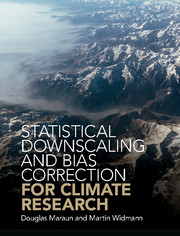Book contents
- Frontmatter
- Dedication
- Contents
- Preface
- Acknowledgements
- 1 Introduction
- Part I Background and Fundamentals
- 2 Regional Climate
- 3 History of Downscaling
- 4 Rationale of Downscaling
- 5 User Needs
- 6 Mathematical and Statistical Methods
- 7 Reference Observations
- 8 Climate Modelling
- 9 Uncertainties
- Part II Statistical Downscaling Concepts and Methods
- Part III Downscaling in Practice and Outlook
- Appendix A Methods Used in This Book
- Appendix B Useful Resources
- References
- Index
4 - Rationale of Downscaling
from Part I - Background and Fundamentals
Published online by Cambridge University Press: 27 December 2017
- Frontmatter
- Dedication
- Contents
- Preface
- Acknowledgements
- 1 Introduction
- Part I Background and Fundamentals
- 2 Regional Climate
- 3 History of Downscaling
- 4 Rationale of Downscaling
- 5 User Needs
- 6 Mathematical and Statistical Methods
- 7 Reference Observations
- 8 Climate Modelling
- 9 Uncertainties
- Part II Statistical Downscaling Concepts and Methods
- Part III Downscaling in Practice and Outlook
- Appendix A Methods Used in This Book
- Appendix B Useful Resources
- References
- Index
Summary
In this chapter, we discuss the basic ideas, assumptions and concepts underlying downscaling. The concept itself is considered in Section 4.1. In different user contexts, different aspects of the climate system – expressed in statistical terms – will be relevant. We introduce these aspects in Section 4.2. Each downscaling model is based on a set of assumptions; these are presented in Section 4.3. But also the downscaled model itself has to fulfill specific requirements, as will be discussed in Section 4.4. In Section 4.5 we will discuss remaining issues such as added value.
What Is Downscaling?
As already introduced in Chapter 1, the main rationale and purpose of downscaling is to bridge the gap from the large spatial scales represented by GCMs to the smaller scales required for assessing regional climate change and its impacts. Dynamical downscaling employs regional climate models (RCMs) to simulate the atmosphere and its coupling with the land-surface at a higher resolution, but over a limited domain (Rummukainen 2010). Boundary conditions are taken from the driving GCM. Statistical downscaling derives empirical links between large and local scales and applies these to climate model output. The two main variants of statistical downscaling have already been sketched in Chapter 1; they will be introduced in more detail in Part II. For now only the basic difference is important: so-called perfect prognosis statistical models – essentially all regression and weather type methods – are calibrated against observed large-scale predictors and local-scale predictands. Under climate change, the statistical model is applied to predictors from a GCM. So-called model output statistics methods – essentially all bias correction methods – calibrate a transfer function between climate model simulations and observations in present climate, and apply this transfer function to future climate model simulations. Given that bias correction is often applied to RCMs rather than directly to GCMs, we will in the following sections discuss not only statistical but briefly also dynamical downscaling.
Generally speaking, downscaling uses additional information from regional or local scales that is not present in GCMs to derive information about regional climate and climate change, conditional on the driving GCM. RCMs resolve regional-scale processes and use regional information on the orography; statistical downscaling uses information on observed climate at selected locations.
- Type
- Chapter
- Information
- Publisher: Cambridge University PressPrint publication year: 2018

